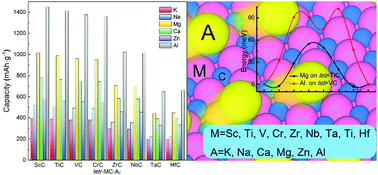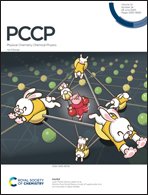Two-dimensional tetragonal transition-metal carbide anodes for non-lithium-ion batteries†
Abstract
Searching for high-performance anode materials with high energy-density, fast kinetics, and good stability is a key challenge for non-lithium-ion batteries (NLIBs), such as Na+, K+, Mg2+, Ca2+, Zn2+ and Al3+ ion batteries. Here, we systematically investigated the performance of a new class of two-dimensional tetragonal transition-metal carbides (tetr-MCs) using first-principles calculations, as anodes for NLIBs. The results show that tetr-MCs are ideal anode materials with good stabilities, favorable mechanical properties, intrinsic metallic properties, high theoretical capacities, and fast ion diffusion rate for NLIBs. Among all tetr-MCs, we found that the energy barrier of Mg atoms on tetr-TiC is only 54 meV and that of Al atoms on tetr-VC is 101 meV, which are lower than the energy barriers of 230–500 meV of the well-studied MXenes, indicating that tetr-VC and tetr-TiC monolayers are promising anodes for NLIBs. Therefore, compared to MXenes, tetr-MCs show many advantages for NLIB applications, such as a lower diffusion barrier (minimum 54 meV), a high theoretical capacity (up to 1450 mA h g−1), and a lower average open circuit voltage (0.05–0.77 V). The results are of great significance for the experimental preparation of excellent anode materials for NLIBs.



 Please wait while we load your content...
Please wait while we load your content...